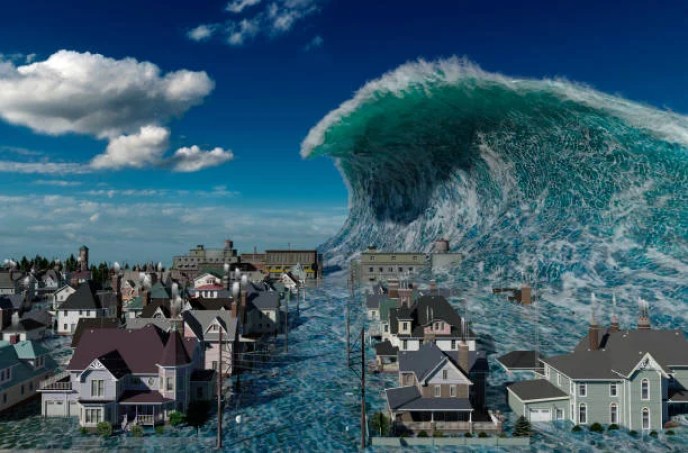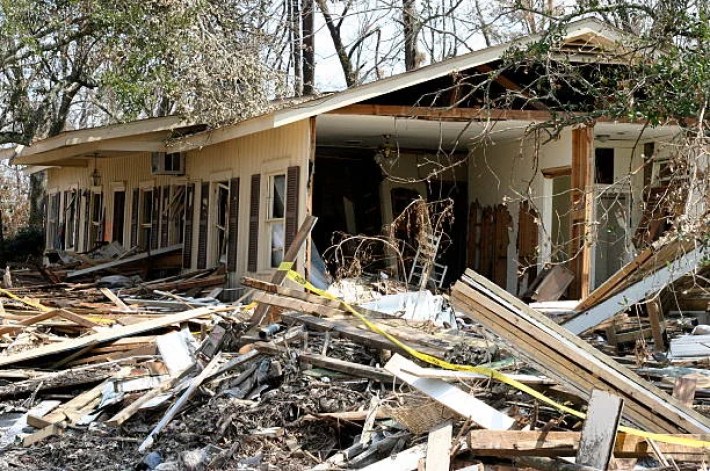Introduction:
- The word “tsunami” is borrowed from the Japanese tsunami 波 t, meaning “harbor wave”.A tsunami is a set of waves caused by the displacement of a set of waves in a body of water into an ocean or large lake. Earthquakes below the surface of the water, volcanic eruptions, and other underwater explosions (including explosions, landslides, glaciers, meteorite impacts, and other disturbances) can cause a tsunami. The normal waves are created by wind or tides, tides are formed as a result of the gravitational pull of the moon and sun, and tsunamis cause water movements.
Tsunamis are Ocean Waves triggered by:
- Large earthquakes that occur near or under the Ocean.
- Volcanic eruptions.
- Submarine landslides.
- Onshore landslides in which large volumes of debris fall into the water.
Overview Creation of Tsunamis:
- Tsunamis are usually made up of multiple floods, like fast tides with strong currents.
- When tsunamis approach the coast, they act like a very fast-moving tide, extending inland much farther than normal water.
- If the disturbance caused by the tsunami occurs near the coast, as a result, a tsunami can reach coastal communities within minutes.
- The general rule is that if you see a tsunami, it is too late to overcome it.
- Even small tsunamis (6 feet high, for example) are associated with very strong currents that can remove someone from their feet.
- Due to the complex interactions with the coast, tsunami waves can last for many hours.
- As with many natural phenomena, tsunamis can range in size from micro-tsunamis detectable only by sensitive instruments on the ocean floor to mega-tsunamis that can affect the coastlines of entire oceans.
Tidal waves
- Tidal waves are sometimes called tidal waves.
- This once-popular concept originates from the most common occurrence of the tidal wave, which is an unusually wide tidal path.
- Tidal waves and tides create waves of water moving inland, but in the case of a tidal wave, the movement of water can be much greater and indicates an incredibly large and strong tide.
- In recent years, the term “tsunami” has fallen out of favor, especially in the scientific community, because the causes of tidal waves have nothing to do with the cause of the tides, it results from the pulling of the moon and sun, not the motion of water.
- Although the meaning of “tide” includes “commemorate” or “the shape or character of the tides,” maritime people and maps discourage the use of the word wave.

Fig 1: Tsunami wave apocalyptic water view urban flood Storm
Source image: https://pixabay.com/images/search/tsumnami
Seismic wave
- The term Seismic Wave also refers to an event because waves are usually caused by movements such as earthquakes.
- Before the use of the word tsunami began in English, scholars often insisted on using the term tsunami wave instead of the tsunami wave.
- Like a tsunami, ocean waves are not fully timed, as a force other than earthquakes – including submarine landslides, volcanic eruptions, submarine eruptions, landslides or ice falling into the ocean, weathering, and the effects of meteorites.
- Velocity waves can form with water exchange.
Movement of Tsunami
- When a tsunami occurs, its speed depends on the depth of the ocean. In the deep ocean, a tsunami can move as fast as a jet, at more than 500 mph, and its wavelength, from crest to crest, can be hundreds of miles.
- Sailors at sea usually do not notice a tsunami when passing under them; in deep water, the top of the wave rarely reaches more than three meters higher than the swelling of the ocean.
- The NOAA Deep Sea Survey and Report on Deep Ocean Tsunami (DART) systems can detect minor changes in altitude and transmit this information to tsunami alert centers.
Tsunami Effects on Humans
- Major tsunamis are significant threats to human health, property, infrastructure, resources, and savings.
- The effects can be long-lasting and feel far beyond the shoreline. Tsunamis usually cause the most serious damage and casualties near their source, where there is little time for warning.
- Large tsunamis can also hit distant shorelines and cause widespread damage. The tsunami in the Indian Ocean in 2004, for example, affected 17 countries in Southeast and South Asia and East and South Africa.

Prediction of Tsunami
- Scientists cannot predict when and where the next tsunami will occur. But tsunami warning stations know which earthquakes are likely to create tidal waves and can send messages whenever possible.
- They monitor deep-sea and coastal seawater network systems designed to detect tidal waves and use information from these networks to predict the impact of coastal areas and guide local evacuation decisions.
- The tsunami warning capabilities have been dramatically improved since the 2004 Indian Ocean tsunami.
- NOAA scientists are working to further improve the work of alert centers and help communities be prepared to respond.
Causes of Tsunamis
Subduction Zones:
We know about Mostly tsunamis are caused by earthquakes in the subduction zone, an area where oceanic plate enters the mantle under tectonic forces. The friction between the subductive plate and the top plate is enormous. This friction prevents a slow and stable subduction speed and instead the two plates “fit together”.
Accumulated Seismic Energy:
As the blocked plate continues to descend into the jacket, the movement causes a slow distortion of the overlapping plate. The result is an accumulation of energy very similar to the energy stored in a compressed spring. Energy can accumulate on the mainboard over a long period of time – decades or even centuries.
Earthquake Causes Tsunami:
The energy accumulates in the upper plate until it exceeds the friction forces between the two blocked plates. When this happens, the top plate is fixed back in an unfenced position. This sudden movement is the cause of the tsunami – because it gives a huge pressure to the water above. At the same time, the inner areas of the upper plate are suddenly lowered.
Tsunami Races Away from the Epicenter:
The moving wave begins to move from where the earthquake occurred. Some water moves over the ocean and, at the same time, the water flows into the land to flood the nearby coast.
Rapidly Across Ocean Basin:
Fast-moving travel along the ocean. The map on this page shows the suddenness of a tsunami triggered by an earthquake off the coast of Chile in the 1960s, crossing the Pacific Ocean, and arriving in Hawaii in about 15 hours with Japan in less than 24 hours.
Video: Tsunami Ocean Wave
Source: https://pixabay.com/videos/waves-wave-tsunami-beach-ocean-31629/
Prevention majors of Tsunami Disaster Situation
Prevention Majors Before Tsunami
- If you are in a Tsunami prone region you first need to save or protect yourself from an earthquake.
- Immediately try to get to the high land place as far inland as possible.
- Switch away from the sea to the elevated ground outside of flood threat zones to shield yourself from the impact of a tsunami.
- Keep on the lookout for tsunami warning signals, such as a sudden rising or drainage of coastal waters.
- After any major earthquake Always alert to the emergency information and alerts.
- DO NOT WAIT TO EVACUATE! If you see the natural indication of a tsunami or get an official tsunami warning, get out as quickly as possible.
- Often follow local emergency response authorities’ orders. They send you the most up-to-date tips depending on the danger in your neighborhood.
- Always has a backup plan to the shelter with friends and family, if possible
- Go out to see if you’re on a cruise.
- Learn about the tsunami risk in your region whether you live near or often visit a coastal area. Maps of evacuation areas and roads are accessible in some at-risk areas. Inquire for city planning if you’re a tourist.
- Learn to recognize the warning signals of a possible tsunami, such as an earthquake, a strong roar from the sea, or irregular ocean activity, such as a rapid increase or wall of water, or sudden drainage of water exposing the ocean floor.
- Know and follow the community’s contingency plans, as well as your routes to and from work, education, and recreation.
- Choose a shelter that is at least a mile inland and 100 feet above sea level.
- Establish an out-of-state line with your family’s emergency communication plan. Have a schedule for where you would meet if you become divided.
- Consider earthquake insurance and a flood insurance policy through the National Flood Insurance Program (NFIP).
Prevention Majors During Tsunami
- When you’re in a tidal zone and there’s an earthquake, the first thing you can do is shield yourself from the quake. Down, Cover, and Hang On is a term that means “down, cover, and hold on.”
- Kneel flat on your hands and knees. With your arms, cover your head and hands.
- When there are natural signs or official tsunami warnings after the shaking ceases, get to a high and far inland position as soon as possible.
- If you are not in a tsunami danger zone and get a tsunami warning, keep put until authorities tell you otherwise.
- If you’re advised to leave, do so immediately. A wave with an arrow pointing to higher ground is also used to signify escape routes.
- If you’re on a cruise, turn around and go out to the shore, facing the waves.
Prevention Majors After Tsunami
- Always carry a radio for getting the alerts and authorities for information about the current situation.
- Floodwaters can contain harmful waste, so stop wading through them. Water may be deeper than it appears.
- Be aware of the possibility of electrocution. Water may be electrically charged by underground or downed power lines. Don’t try to touch any electrical equipment if you are standing in water.
- If you are experiencing medical help, call to local helpline number and let them tell you about your actual situation.
- Always stay far away from the damaged buildings, roads, and bridges, and other affected bodies during the Tsunami shock.
- If you’re distressed, take care of your body and talk to someone.
- The most important major is to safe first yourself then help others and save more lives.

